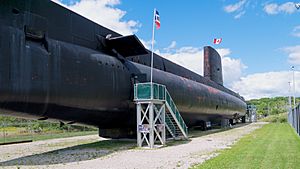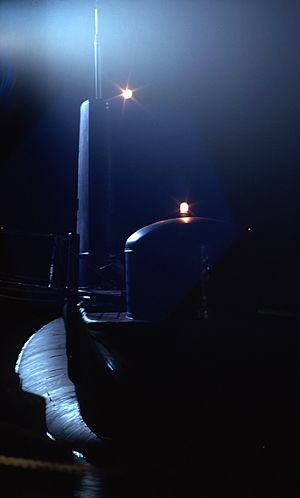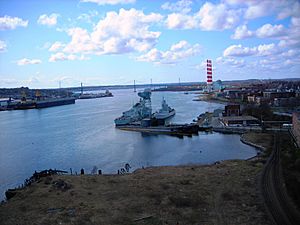HMCS Ojibwa facts for kids
class="infobox " style="float: right; clear: right; width: 315px; border-spacing: 2px; text-align: left; font-size: 90%;"
| colspan="2" style="text-align: center; font-size: 90%; line-height: 1.5em;" | 
|}
A Canadian Oberon-class submarine alongside in Roosey Roads for Operation Springboard, January 1969
HMCS Ojibwa was a special type of submarine called an Oberon-class submarine. It served in the Royal Canadian Navy (RCN) and later the Canadian Forces Maritime Command. This submarine was first meant for the British Royal Navy and was called HMS Onyx. But before it was finished, Canada bought it. Ojibwa started serving in the RCN in 1965.
It mostly worked with Maritime Forces Atlantic until it was taken out of service in 1998. In 2010, Ojibwa was waiting to be taken apart at CFB Halifax. However, the Elgin Military Museum wanted to save it and turn it into a museum ship. The submarine was moved to Port Burwell, Ontario in 2012. It opened to visitors in 2013 and is now a main part of a new Museum of Naval History being built there.
Contents
| History | |
|---|---|
| Name | Onyx |
| Builder | Chatham Dockyard, Chatham |
| Laid down | 27 September 1962 |
| Fate | Sold to Canada while under construction |
| Name | Ojibwa |
| Namesake | Ojibwa First Nations people |
| Launched | 29 February 1964 |
| Acquired | 1963 |
| Commissioned | 23 September 1965 |
| Decommissioned | May 1998 |
| Identification | S 72 |
| Fate | Transferred to Elgin Military Museum 2 December 2011 |
| Status | Museum ship at Port Burwell, Ontario since 2013 |
| Badge | Blazon Azure, an escallop shell erect argent irradiated by nine ears of wild rice or, all issuing from two barrulets wavy of the last, in base. |
| General characteristics | |
| Class and type | Oberon-class submarine |
| Displacement |
|
| Length | 295.25 ft (89.99 m) |
| Beam | 26.5 ft (8.1 m) |
| Draught | 18 ft (5.5 m) |
| Propulsion |
|
| Speed |
|
| Range | 9,000 nautical miles (17,000 km; 10,000 mi) at 12 kn (22 km/h; 14 mph) |
| Endurance | 258 t of oil, 56 days |
| Test depth | 120 metres (390 ft)-180 metres (590 ft) |
| Complement | 69 |
| Sensors and processing systems |
|
| Electronic warfare & decoys |
MEL Manta UAL or UA4 radar warning |
| Armament | 8 × 21 in (533 mm) tubes (6 bow, 2 stern), 30 torpedoes |
Submarine Design and Features
The Oberon class submarines were an improved version of older Porpoise-class submarines. They had a stronger hull and were made from better steel. This allowed the Oberon submarines to dive deeper, up to about 1,000 feet (300 m).
These submarines weighed 2,030 tonnes (2,000 long tons) when on the surface and 2,410 tonnes (2,370 long tons) when underwater. They were about 295 ft 1⁄4 in (89.922 m) long. Their width, called the beam, was 26 ft 1⁄2 in (7.938 m). The depth they sat in the water, called the draught, was 18 ft (5.5 m).
The submarines used a diesel-electric system with two shafts. They had two ASR 1 16-cylinder diesel engines that made 3,680 brake horsepower (2,740 kW) of power. They also had two English Electric motors that made 6,000 shaft horsepower (4,500 kW). This allowed the submarines to travel at a top speed of 12 knots (22 km/h; 14 mph) on the surface and 17 knots (31 km/h; 20 mph) when submerged. They could carry 258 tons of oil, giving them a range of 9,000 nautical miles (17,000 km; 10,000 mi) at 12 knots.
The submarines were armed with eight 21-inch (533 mm) torpedo tubes. Six were at the front (bow) and two were at the back (stern). They carried 24 extra torpedoes, making a total of 30. Canadian submarines were different because they used US Mark 37C torpedoes. Longer, wire-guided versions were used in the front tubes, and non-guided versions in the back tubes.
Oberon submarines also had different types of sonar to detect things underwater. These included Type 187 active-passive sonar, Type 2007 passive sonar, and Type 2019 sonar.
Submarine Upgrade Program (SOUP)
By the late 1970s, the Oberon submarines used by Canada were getting old. They needed to be updated. A plan was made in 1978 and approved in February 1979. This program was called the Submarine Operational Update Program (SOUP).
The goal was to change the submarines from just training ships to active warships. The program added new sonars, periscopes, communication systems, and fire-control systems. Their weapons were also improved. They got new torpedo tubes that could fire the Mark 48 torpedo. This allowed the submarines to help NATO watch for Soviet submarines in the North Atlantic.
The SOUP upgrades included a new US fire control system and a new Sperry passive sonar. New communication and navigation systems were also put in. The submarines got new torpedo tubes for Mark 48 torpedoes. However, the torpedoes themselves were bought separately later in 1985.
From 1980 to 1986, one Canadian Oberon submarine was always being upgraded. The SOUP program finished on time and within its budget of C$45 million in 1986. SOUP kept the Canadian Oberon submarines working until the late 1990s. They were then replaced by British Upholder-class submarines.
How Canada Acquired the Submarines
In March 1962, the Canadian government decided to buy three Oberon submarines and eight frigates. This purchase depended on the United Kingdom buying defence products from Canada to balance the cost. On April 11, 1962, the purchase was announced in the House of Commons of Canada.
However, the government at the time delayed buying the submarines because the UK was slow in making its purchases from Canada. That government was later replaced in 1963. The new government stopped all big defence projects. To help the deal move forward, the UK offered two other submarine hulls, Ocelot and Opportune, but Canada didn't take them. When Onyx became available, Canada accepted the offer.
The final price for the whole deal was C$40 million in 1963. But because Canada wanted some changes to the design, the cost went up to C$51.4 million.
Since Onyx was already being built, it was finished to the Royal Navy's plans. All three submarines bought by Canada had some changes from the original Oberon design. These changes included a larger snort de-icer, different weapons, a bigger air conditioning unit, active sonar, and different communication equipment. The second and third submarines were built exactly to Canadian needs. This meant moving the kitchen area forward to make space for sonar equipment. This change, however, meant three fewer beds for the crew, which was a problem that was never fixed. These three submarines were bought mainly for training. They were used to help surface ships practice anti-submarine warfare.
Building and Service of HMCS Ojibwa
The submarine was first ordered for the Royal Navy as HMS Onyx. Its construction began at Chatham Dockyard on September 27, 1962. In 1963, the submarine was transferred to the Royal Canadian Navy. It was launched as HMCS Ojibwa on February 29, 1964. Ojibwa officially started service on September 23, 1965, at Chatham Dockyard. The submarine was named after the Ojibwe First Nations people and was given the pennant number S 72.
Ojibwa joined the First Canadian Submarine Squadron on April 22, 1966. It served almost its entire career with Maritime Forces Atlantic (MARLANT) in the North Atlantic. Early on, there were some crew issues on Ojibwa. Rear-Admiral William Landymore had to step in and remove the submarine's commander. Ojibwa also spent time training with the Royal Navy. This was part of an exchange program started in the 1960s. This program allowed Canadian submarines to go on intelligence-gathering missions.
Starting in the 1970s, Canada began underwater patrols in the western Atlantic. They tracked Soviet submarines and surface ships, especially ballistic missile submarines. These patrols were often done with Argus or Aurora patrol aircraft. In 1977, Ojibwa made a short trip to British Columbia to train with Maritime Forces Pacific (MARPAC).
Ojibwa began its SOUP upgrade in 1979. It arrived at HMC Dockyard in Halifax, Nova Scotia, on June 18 to get ready. The upgrade started on February 20, 1981, and finished on May 31, 1982. After the SOUP upgrade and getting the Mark 48 torpedoes, the Oberon submarines were considered fully ready for combat. From November 14 to December 6, 1983, Ojibwa performed an anti-Soviet submarine patrol for NATO. The submarine went on another patrol in March 1985 and found a Soviet Delta-class submarine. This Delta-class submarine passed within 800 yards (730 m) of Ojibwa, which tracked it for two days. On March 20, Ojibwa was detected by a Soviet Victor-class submarine and stopped tracking both submarines.
After the Cold War ended, the Oberon submarines got new tasks. From 1991 to 1994, they patrolled for Canadian government groups like the Department of Fisheries and Oceans. For six months in 1994, the submarine served on the west coast. The new Victoria-class submarines were delayed, so the Oberons had to work longer than expected. In 1994, Ojibwa was cut in half. Its old engines were removed and replaced with newer ones from HMS Osiris. These engines were bought from the Royal Navy in 1992 for spare parts.
During the Turbot War, the Oberon submarines watched European fishing fleets near the Grand Banks of Newfoundland. Their presence helped calm the growing conflict. In 1997, Ojibwa made another short trip to the west coast. This trip had many problems, as the submarine had mechanical and technical issues. It was officially taken out of service from MARCOM on May 21, 1998.
Ojibwa as a Museum Ship
In May 2005, a newspaper reported that MARCOM planned to sell Ojibwa for scrap metal. Three other Canadian Oberon submarines were also to be sold. MARCOM said the submarines were not in good enough shape to be used as museum ships. They thought each submarine would sell for about C$50,000 to C$60,000. After being taken out of service, Ojibwa was used in "shock" testing in 2010. This testing left a noticeable dent on its left side.
On June 11, 2010, it was announced that Ojibwa would be moved by BMT Fleet Technology Ltd. It would become part of the collection at the Elgin Military Museum in St. Thomas, Ontario. On December 2, 2011, the Department of National Defence approved the transfer of Ojibwa to the Elgin Military Museum. The final agreement was signed on May 25, 2012, after three years of talks.
On May 26, 2012, Ojibwa began its journey from Halifax, Nova Scotia, to Hamilton, Ontario. It traveled through the St. Lawrence Seaway. The submarine was moved with the help of tugboats named Florence M and Lac Manitoba, and a tow called HM-1. It stayed in Hamilton at Heddle Marine Dockyards. There, it was repainted and fitted with special supports to move it over land. On November 18, 2012, Ojibwa, on a barge named HM 08, completed the last part of its journey. It went through the Welland Canal and then Lake Erie from Hamilton to Port Burwell. It was pulled by the tugs Lac Manitoba and Seahound.
The submarine arrived in Port Burwell on November 20 after a short trip. It became part of a new Museum of Naval History. The museum opened for tours on June 29, 2013. In April 2015, there were financial issues about moving the submarine to Port Burwell. The Royal Bank of Canada asked the community to pay back a $6 million loan.



